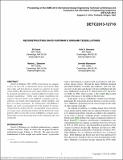Reconstructing David Huffman’s Origami Tessellations
Author(s)
Davis, Eli; Demaine, Erik D; Demaine, Martin L; Ramseyer, Jennifer E.
DownloadPublished version (7.122Mb)
Terms of use
Metadata
Show full item recordAbstract
David A. Huffman (1925-1999) is best known in computer science for his work in information theory, particularly Huffman codes, and best known in origami as a pioneer of curvedcrease folding. But during his early paper folding in the 1970s, he designed and folded over a hundred different straight-crease origami tessellations. Unlike most origami tessellations designed in the past twenty years, Huffman's straight-crease tessellations are mostly three-dimensional, rigidly foldable, and have no locking mechanism. In collaboration with Huffman's family, our goal is to document all of his designs by reverseengineering his models into the corresponding crease patterns, or in some cases, matching his models with his sketches of crease patterns. Here we describe several of Huffman's origami tessellations that are most interesting historically, mathematically, and artistically. Keywords: Collaboration, Computers, Reverse engineering
Date issued
2014-02Department
Massachusetts Institute of Technology. Computer Science and Artificial Intelligence LaboratoryJournal
Proceedings of the ASME 2013 International Design Engineering Technical Conferences and Computers and Information in Engineering Conference
Publisher
ASME International
Citation
Davis, Eli, Erik D. Demaine, Martin L. Demaine, and Jennifer Ramseyer. "Reconstructing David Huffman’s Origami Tessellations." in Proceedings of the ASME 2013 International Design Engineering Technical Conferences and Computers and Information in Engineering Conference, IDETC/CIE 2013, August 4-7, 2013, Portland, Oregon, USA. Copyright © 2013 by ASME.
Version: Final published version
Other identifiers
DETC2013-12710
V06BT07A034
ISBN
9780791855942
0791855945